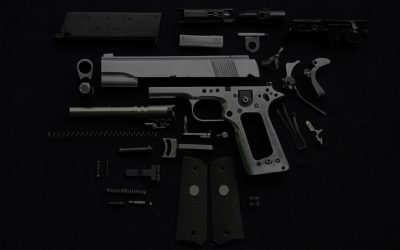Skip’s Tips > Newsletters > Selecting Wood
Selecting Wood
The most beautiful wood comes from “quarter sawn” wood.
Skip Walters


Sign up to receive insider tips from our Master Gunsmith!
Although a large percentage of modern firearms are equipped with polymer or fiberglass stocks, these stocks cannot compare with the natural beauty, artistry and skill associated with a wood stock. Though many woods are plain and without much color or figure, a properly selected piece of wood can be colorful, highly figured and very strong.
The most beautiful wood comes from “quarter sawn” wood. To understand what this means, picture the circle formed by the trunk of a tree. Slice the circle into four 90 degree slices, or quarters. These pieces are laid on their outer arcs and vertically sliced into boards at least 2” thick. Quarter sawn wood warps toward what would be the point of the quarter as it dries and ages. This method maximizes the figure and strength of the wood as well as keeps warping to a minimum. More wood is wasted when trees are cut in this manner, so lumber for construction or furniture is usually “board sawn”. When board sawn, the wood is simply sliced as if it was a carrot, placed sideways, in a slicer. This method allows the wood to warp and twist as it dries. This is not good for gunstocks, though economy stocks are frequently found to be from board sawn lumber.
A beautiful, strong gunstock should have been dried to a moisture content of 7%, be of medium density wood and have the wood grain run slightly upward toward the barrel channel and directly toward the recoil force exerted on the action at recoil/bedding points. Medium density wood comes from maple, walnut, fruit and nut trees. Wood such as poplar, almond or tulip is suitable, but very plain. The oaks are dense, very heavy and difficult to fill and finish. Pine is much too soft for gunstocks. Medium density wood is a good compromise between strength, weight, resistance to warping and ease of working and finishing.
With the wood grain running upward toward the barrel channel, any warping of the forearm wood will be toward the barrel. The warped wood is easily relieved and the wood to metal fit is maintained. If the grain runs in a different manner, the wood would pull away from the metal and the resultant unsightly gaps would certainly detract from the appearance and function of the firearm.
Go to next article >

More From Skip Walters
Only as Good as the Barrel
The Center of Your Shop
Choosing a Self-Defense Handgun

Polishing Gun Metal

Use Promo Code AIM to save

Free Resources to start your training
